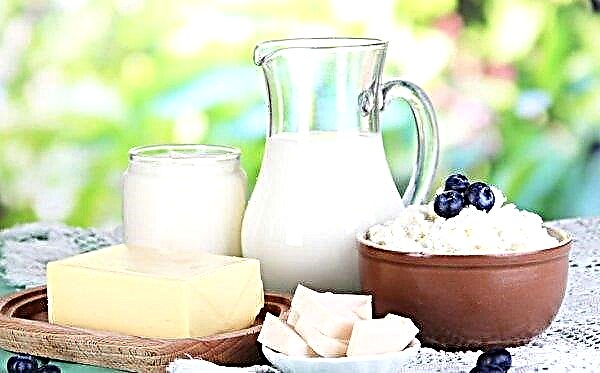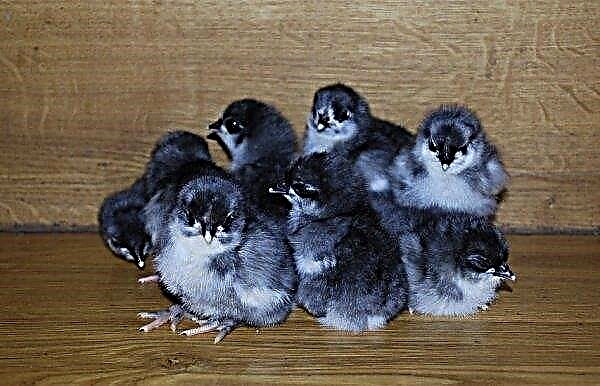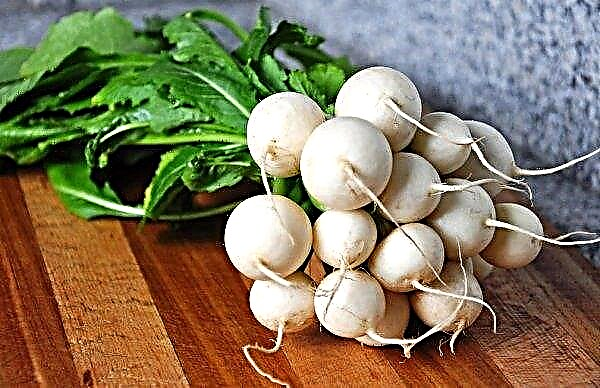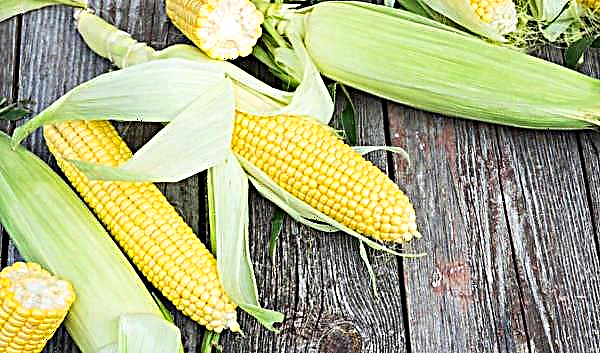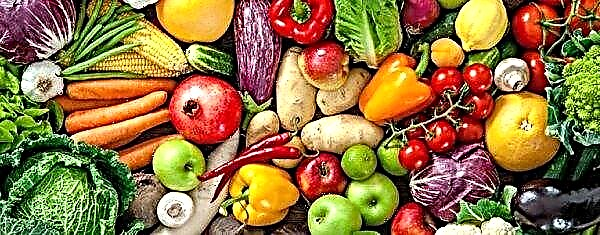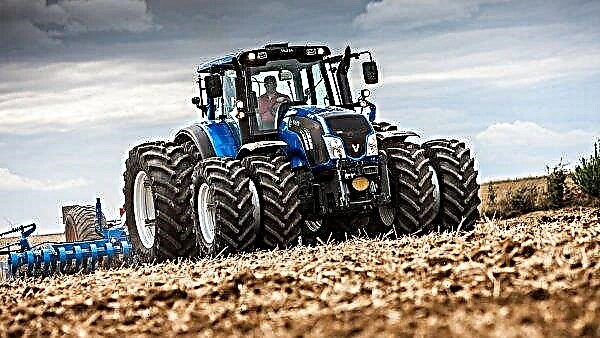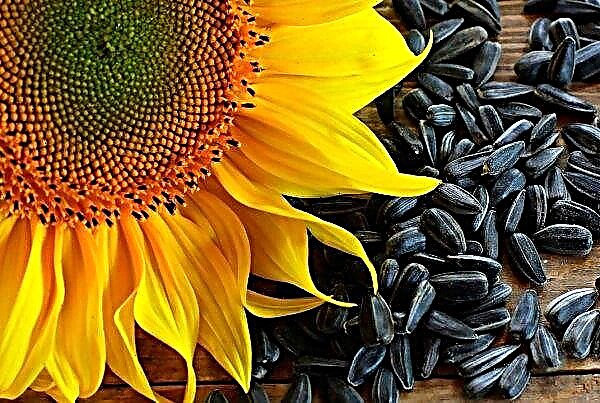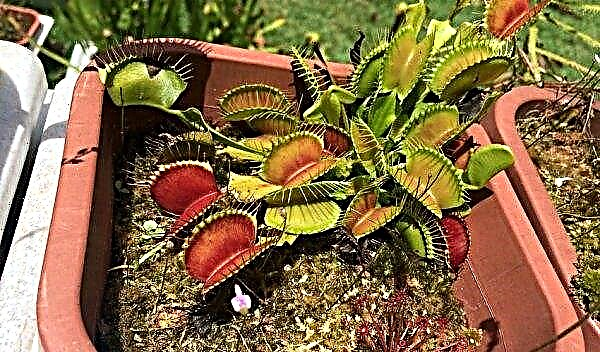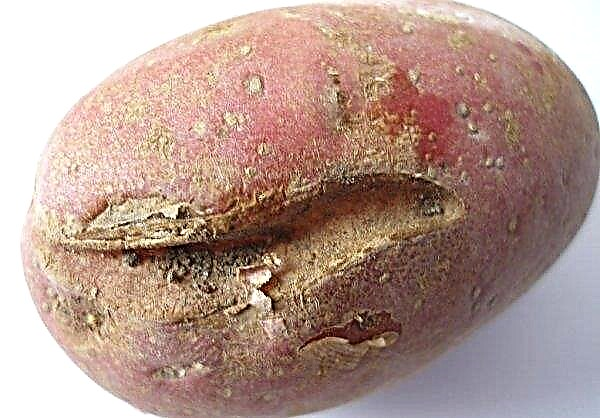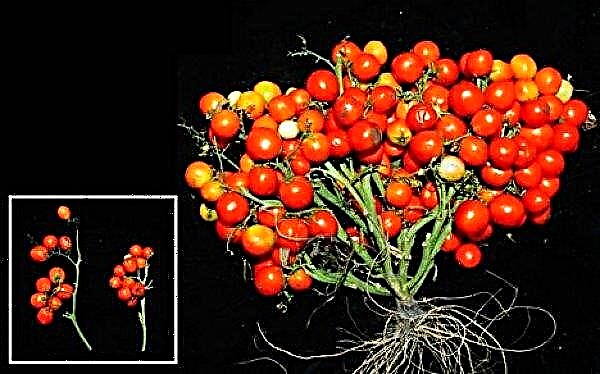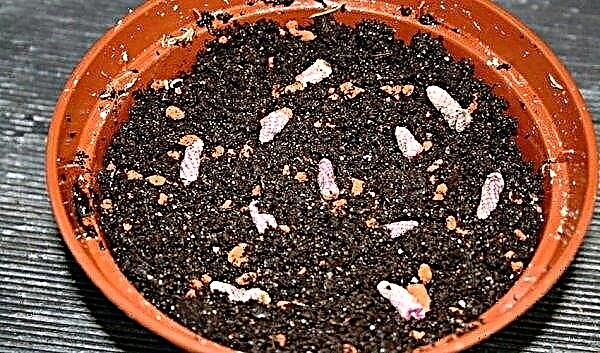Cherry Nord Star is one of those universal and absolutely unpretentious varieties that may be of interest even to beginner gardeners who have never before been engaged in the cultivation of these berries on their sites. Moreover, this variety, due to its endurance and unpretentiousness, is very appreciated in difficult climates. We consider in this article all the features of Nord Star that will help to understand why this particular cherry attracts farmers so much and why professional gardeners plant it in their gardens.
Selection history
The history of the Nord Star variety does not contain accurate information. It is known for certain that it was bred in the state of Minnesota (USA) by hybridization of the Lotovaya variety (belongs to the old self-fertile West European varieties with moderate frost resistance and immunity to fungal infections), as well as a seedling that was grown from an unexplored cherry variety imported from Serbia in early 20th century.

In the mid-80s of the last century, a new variety was included in the VNIISPK database, but to date in the State Register of Selection Achievements of the Russian Federation data on Nord Star have not been preserved.
Botanical description and characterization of the variety
Cherry Nord Star belongs to late ripening varieties, the harvest of which can be harvested from the second half of July to the beginning - mid-August, however, depending on climatic and weather conditions, these periods may shift somewhat.
Did you know? Cherry is a carrier of volatile - a substance that, according to doctors, is a natural antibiotic.
The variety is quick-growing and high-yielding - already from the second year of life, the first fruiting begins. Berries Nord Star are used not only in fresh form, but also in technical processing (juices and preservation).
Wood
Trees of this variety are stunted; by the 10th year of life they can reach a height of up to 2–2.5 m. Crohn is quite compact and has a regular, rounded shape. The growth rate of the tree is very high at a young age and moderate, starting from the fruiting period.

The bark of the trunk and branches is dark brown. The foliage is medium-sized and glossy, dark green in color. Oval leaves with bicapillary edges resemble in their shape a boat with a round base and a pointed tip. White flowers are saucer-shaped.
Fruit
Nord Star cherries have medium-sized berries and can reach 4–4.5 g. The shape of the fruit is round and broadly round, the tip is rounded. The skin has a dark red or burgundy hue. The pulp is soft and juicy in taste.
Taste qualities are rated as satisfactory (about 4.0 points), having a pronounced acidic hue, which becomes softer when the fruits reach full maturity. One berry contains 9.2% sugar and 1.5% free acids. The bone mass is small - 0.2 g. When tearing off the stem, the berry remains dry.

Pollinators
Nord Star refers to varieties that have the ability to use their pollen without pollinators (self-fertile variety) for the formation of ovaries, and are also prone to self-pollination. In the study of the difficulties of pollination of fruit trees, the experts deduced the dependence of self-fertility on weather conditions and climatic characteristics of the places of life and growth of trees.
It has also been proven that at whatever level self-pollination is possible, additional sources of pollen have a positive effect on the number of ovaries formed. It is noted that Nord Star significantly increases fruiting provided that the following cherries are neighbors: Nefris, Oblachinskaya, Meteor.
Productivity
Nord Star belongs to the high-yielding early-growing varieties. The first crop can be harvested already in the 2nd – 3rd year of a tree’s life, and its volume will increase every year. Cherry reaches its highest fertility starting from 4–5 years of age. The yield of this variety does not fall below 8 kg per tree, but most often reaches 10-12 kg.
Cherry reaches its highest fertility starting from 4–5 years of age. The yield of this variety does not fall below 8 kg per tree, but most often reaches 10-12 kg.
Advantages and disadvantages
Like all other varieties, Nord Star has its own advantages and disadvantages.
- Among the main advantages of this cherry note:
- small tree sizes that facilitate the maintenance process.
- high frost resistance;
- early maturity of the variety;
- stable immunity to many diseases;
- partial autonomy.
The main disadvantage is considered taste indicators, which are not so high - not more than 4.0 points. The main reasons for this are the predominant acid in taste.
Preparation for landing
The selection of seedlings and the process of preparing them for planting are the main stages, the correct passage of which will ensure a rich and stable crop for many years to come.

That is why it is so important to understand the basic rules of this procedure and to ensure in advance all the conditions for the healthy growth and development of the cherry tree in the garden.
Choosing the best seedlings for planting
Despite the fact that the planting of cherry seedlings is usually carried out in the spring, many professionals advise purchasing them precisely in the autumn period due to the wide variety of planting material at this time of the year.
When choosing the seedling itself, it is not recommended to take tall plants with a large number of shoots, since they already have sufficiently developed rhizomes that are difficult to dig without damaging them. One-year-old seedlings will be an ideal option - their survival rate is much higher, and the price is much more profitable.
Important! To check the seedling for dryness, you can bend the root or shoot into a ringlet — they should easily bend, not crunch, and the bark in the bend area should be gathered accordion, but not exfoliate.
When examining seedlings, it is worth noting the following factors for yourself:
- Finding a place for budding - located 7-15 cm from the root neck and slightly bends the trunk, which in this area begins to grow slightly to the side. The absence of such a trait indicates a great possibility that a seedling is on sale, which will subsequently lack varietal traits.
- One-year-old seedlings usually have a height of no more than 90 cm, while two-year-old seedlings are much higher.
- An annual plant has about 8-10 shoots, the length of which can be from 10 to 20 cm. Two-year-olds have at least 12 shoots with branches, up to 25 cm long.
- The root system of annual seedlings is about 25 cm in length.

In the selection process, you should also pay attention to the state of the root system and the aerial parts: rhizomes must be moist, and shoots without growths and damage. You should also know that according to GOST, foliage should be completely absent on seedlings.
Choosing the right place on the site
When choosing a place for planting a future tree, one should take into account that this plot of land should be located on a small elevation, which will exclude the possibility of close occurrence of aquifers, as well as be sufficiently lit. Part of the site near the fence is well suited, which will reliably protect the tree from the wind.
The soil should not be clay or sand, and if necessary, its structure can be improved by applying fertilizers (both organic and mineral). A planting pit for a seedling is prepared several months before the expected planting date - this will give the soil time to sag well.
 The size of the planting pit is determined by the root system of the seedling with a depth of 25 cm and a diameter of about 50-60 cm.
The size of the planting pit is determined by the root system of the seedling with a depth of 25 cm and a diameter of about 50-60 cm.
Landing time
The timing of planting seedlings may vary depending on the climate of a particular region. In a temperate climate, the best time to plant seedlings will be mid-April, when the buds have not yet blossomed, this will give time to the seedlings to take root well in the ground. It is undesirable in such conditions to plant seedlings in the fall, since there is a possibility of their freezing in the winter.
But in the southern regions, autumn planting is quite acceptable, the main thing is to have time to carry out this procedure at least a month before the first frost, so mid-October will be the best time for this process. However, it is known that the richest choice of planting material is in the fall, but it is important to keep it until spring.
In these cases, the seedlings are dug up before the onset of spring:
- Choose a place on the site where the snow does not melt for the longest in the spring, and dig a shallow trench (30-50 cm) in the direction from the west to the east.
- On the south side, the trench is covered with a wall, with an angle of inclination of 45.
- Young trees, the crowns of which should be on the south side, are laid in a row.
- The root system and 1/3 of the trunk are covered with earth.
- Excavation is abundantly watered with water.
- Seedlings are covered with spruce branches, which is designed to protect against rodents.

Step-by-step landing instructions for beginners
The phased landing process looks like this:
- In preparing the landing site, the upper and lower soil layers from the pit are placed separately - the earth of the upper layer is mixed with fertilizer, without which the seedlings will not be able to sufficiently develop or take root. As a top dressing, you can use humus, superphosphate, wood ash or potassium chloride.
- An inspection of the root system is carried out, the damaged parts of which should be removed. If the root system is dry, the seedling is placed in water for 6 hours. Also, immediately before planting, it is recommended to dip the roots into a solution of clay or manure.
- A peg is hammered into the prepared hole, which is covered with the prepared mixture from the upper layer, and then 10 cm with the lower soil layer.
- When planting a plant, it should be noted that 3-4 cm of the root neck should rise above the ground.
- The seedling is covered with a lower layer of soil and carefully tied to a peg. The soil is compacted around a bit, and a near-trunk hole is formed nearby. A young tree is watered with 2 buckets of water, and after the hole is mulched with sawdust.

Features of seasonal care
Like planting rules, proper further care is crucial for the growth and healthy development of the tree. Performing simple procedures, you can easily achieve a quick and rich harvest.
Did you know? According to popular beliefs, pregnant women who eat cherries give birth to healthy children.
Watering, cultivation
Watering should contain such an amount of water that the soil of the near-stem circle is moistened to a depth of 50 cm, but does not sour. Young seedlings require frequent watering, which must be done every two to three weeks, and in the season of high heat - once a week.

Adult plants are watered for the first time immediately after flowering with simultaneous feeding. The second time the trees need additional moisture during the ripening period of the berries. Depending on weather conditions, air temperature and the frequency of rainfall, the amount of water can vary from 3 to 6 buckets for each plant.
In mid-autumn, after the leaves fall, the soil is moistened more intensely - water should penetrate the earth to a depth of more than 70 cm. This procedure increases the winter hardiness of trees and slows down the freezing of soil. During the summer period, about three soil loosening of near-stem soil will be required. But since September, this procedure is not carried out, because it can interfere with the preparation of cherries for wintering.
Top dressing
The first top dressing is introduced when planting seedlings and then depends on the annual growth of branches. With an increase of more than 60 cm, there is no need for fertilizers. But if the growth rate is less than 60 cm, in the autumn period, humus (1/2 bucket for each plant) and 100 g of double superphosphate must be added to the soil.
Important! Farmers who use only organic fertilizers can add EM compost in spring and then periodically spray trees and soil around with biological products.
With the onset of spring, 150 g of ammonium nitrate are also introduced into the soil. Cherries, whose age is more than four years, are fertilized with 20 g of ammonium nitrate and 10 g of double superphosphate. It is also recommended that humus is fed once every 3-4 years with a calculation of 2 kg of humus per 1 m.
Preventative treatment
Among the main diseases that can develop during the life of cherries, the most common are gum disease, coccomycosis (or also called rust), hole blotch, and fruit or gray rot.
Despite the persistent immunity that this variety possesses, it is strongly recommended to carry out systematic preventive treatments:
- treatment with a solution of "Nitrofen", which is carried out 1 time in 3 years;
- annual spraying with a solution of Bordeaux fluid.

Pruning
The cherry tree can quite easily tolerate any pruning, provided that quality care is taken in the future, otherwise the injuries inflicted will not overgrow and can provoke the appearance of gum-detectors. Pruning is carried out in the spring, when the tree survived wintering, but is still at a dormant stage. Such a procedure, subject to its systematic implementation, will be quite enough, which eliminates the need for pruning in the autumn.
Important! In the process of pruning, it must be borne in mind that branches located horizontally give the earliest crop in large quantities.
The process includes the removal of all spoiled, frost-beaten and other unwanted processes and branches, as well as the formation of a crown. Cherries are also prone to root growth. 
Their appearance has a great influence on the quality and quantity of the crop, and therefore they are necessarily cut off at ground level.Places of cuts must be treated with garden varieties, which contributes to early overgrowing.
Winter preparations
The main preparation and shelter of trees for wintering should begin at the end of October, when snow falls. For this, tree branches are pressed and wrapped in bunches of straw or tops, which will reliably protect them from winter frosts. Nord Star refers to undersized varieties that bend either in a circle or fan. Protecting the rhizomes of the tree is quite easy - the earth around is densely covered with a small snowdrift from the snow.
It is also recommended to cover the tree stump with burlap or paper. In early spring, such shelters must be removed immediately to avoid damage to the cherry by the accumulated condensate. It is more difficult to endure winter colds to seedlings, therefore, in the first year, mulching of the trunk circle is also applied to the main shelter (peat or sawdust can be used).
Pest and Disease Control
Among the common diseases and pests that not only affect the condition of the tree and the quality of the crop, but can also lead to the death of the plant, are:
- Perforated spotting (kleasterosporiasis) - manifests itself in the form of small (up to 5 mm in diameter) brown spots, affects both individual fragments and the whole tree. After 1-2 weeks, the spots dry out and crumble, destroying and causing death of the leaves. It can also appear on the berries in the form of dark red spots, which subsequently lead to their drying out. When this disease occurs, the affected parts of the leaves are removed and burned, and the tree itself is treated 2 times every 10 days with Bordeaux liquid.
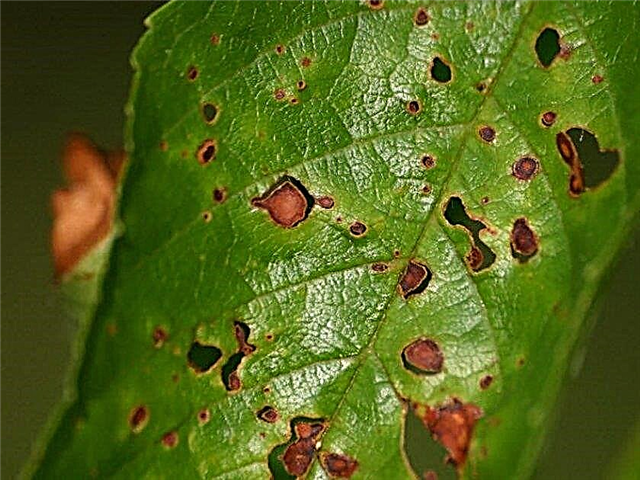
- Coccomycosis - it is found both on berries and on foliage in the form of bright spots of a red tint, which leads to falling of the foliage, lowering the winter hardiness of the tree, and in especially neglected cases, to the death of the plant. As the main treatment, systematic prevention is used, which consists in the destruction of fallen leaves and digging the soil in the spring and autumn. Also, as an effective means, spraying with Bordeaux liquid is used.
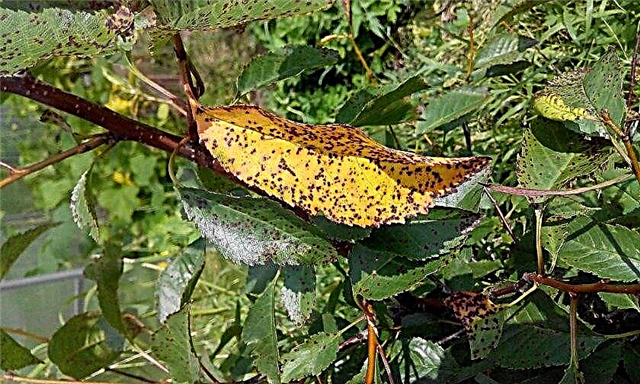
- Fruit rot (moniliosis) - manifests itself in the form of a spot that can literally hit the whole berry in just a few days. Cherries blacken, dry and crumble to the ground. As a treatment and prevention, all infected fruits are removed and fungicides are sprayed.
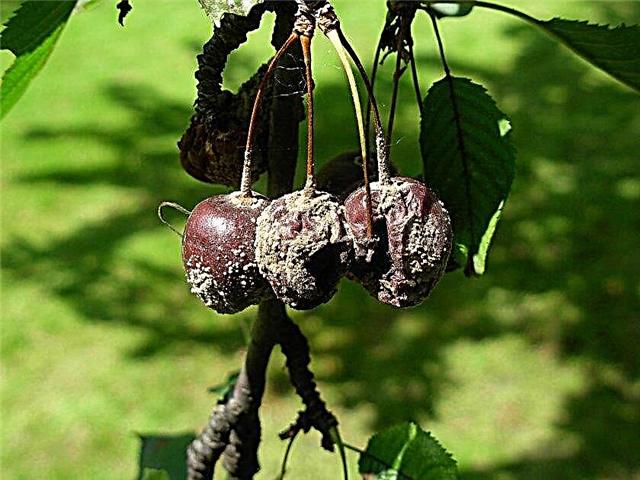
- Cherry sawflies - hit the foliage by destroying the leaf plate. To combat them, trichograms are released in June-July, and chemical preparations are also used.
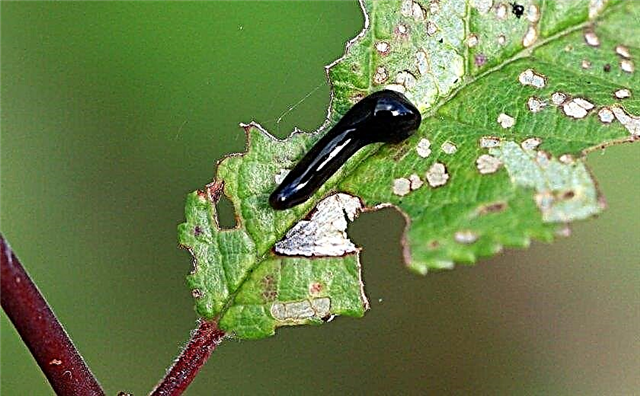
- Leaf aphid - eats leaf juice, thereby destroying them. As a treatment, it is recommended to use chemicals or an infusion of soap and tobacco.

Harvesting and storage
There are two main methods for collecting cherries:
- haircut method - the berries are cut together with part of the stem, which significantly increases its transportability;
- milking method - cherries are collected in waterproof aprons, and then poured into containers lined with paper.
Cherry is not very stubborn - no more than 10-14 days. In order to slightly increase this period, the berries are harvested during the period of technical maturity, selecting only whole and elastic cherries. For storage, the berries are placed in a loose container, with a layer of 5 cm. In the cellar, cherries can be stored for about 10 days, and in the refrigerator for about 2 weeks or more.
Cherry Nord Star is quite common in areas of many gardeners. Despite its low taste characteristics, cherries of this variety are successfully used in canning, as well as in the manufacture of juices. Many advantages of this variety, as well as absolute unpretentiousness in care more than cover all its disadvantages.







